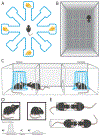Animal Models of Psychosis in Alzheimer Disease
- PMID: 31278012
- PMCID: PMC6858948
- DOI: 10.1016/j.jagp.2019.05.009
Animal Models of Psychosis in Alzheimer Disease
Abstract
Psychosis in Alzheimer Disease (AD) represents a distinct clinicopathologic variant associated with increased cognitive and functional morbidity and an accelerated disease course. To date, extant treatments offer modest benefits with significant risks. The development of new pharmacologic treatments for psychosis in AD would be facilitated by validated preclinical models with which to test candidate interventions. The current review provides a brief summary of the process of validating animal models of human disease together with a critical analysis of the challenges posed in attempting to apply those standards to AD-related behavioral models. An overview of phenotypic analogues of human cognitive and behavioral impairments, with an emphasis on those relevant to psychosis, in AD-related mouse models is provided, followed by an update on recent progress in efforts to translate findings in the pathophysiology of psychotic AD into novel models. Finally, some future directions are suggested to expand the catalogue of psychosis-relevant phenotypes that may provide a sturdier framework for model development and targets for preclinical treatment outcomes.
Keywords: Alzheimer disease; Psychosis; animal model; dementia; mouse; preclinical.
Copyright © 2019 American Association for Geriatric Psychiatry. Published by Elsevier Inc. All rights reserved.
Figures


References
-
- Sweet RA, et al., Psychotic symptoms in Alzheimer disease: evidence for a distinct phenotype. Molecular Psychiatry, 2003. 8(4): p. 383–392. - PubMed
-
- Lopez OL, et al., Psychiatric symptoms vary with the severity of dementia in probable Alzheimer's disease. Journal of Neuropsychiatry and Clinical Neurosciences, 2003. 15(3): p. 346–353. - PubMed
-
- Ropacki SA and Jeste DV, Epidemiology of and risk factors for psychosis of Alzheimer's disease: a review of 55 studies published from 1990 to 2003. Am. J. Psychiatry, 2005. 162(11): p. 2022–2030. - PubMed
Publication types
MeSH terms
Grants and funding
LinkOut - more resources
Full Text Sources
Medical

